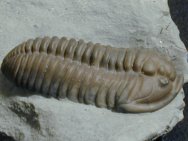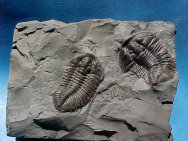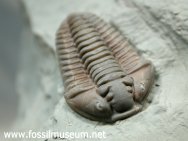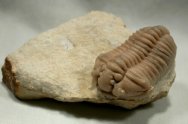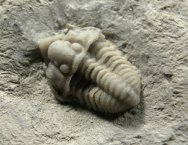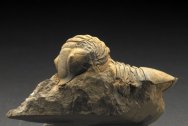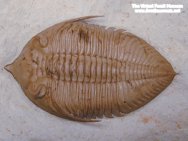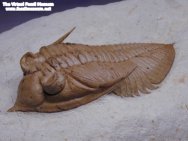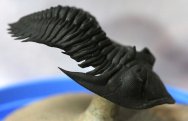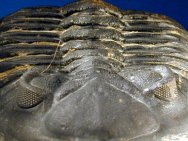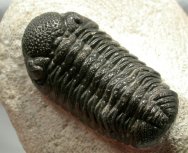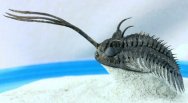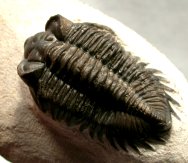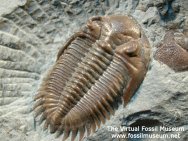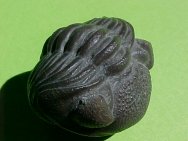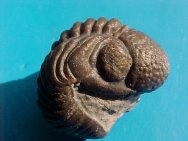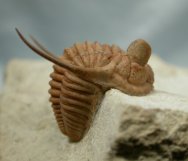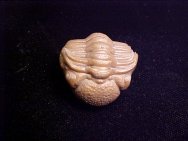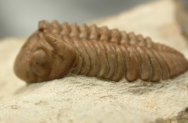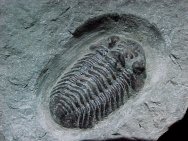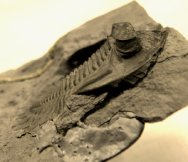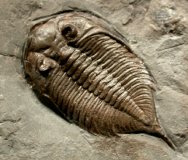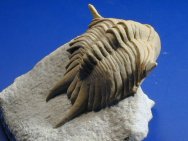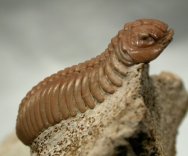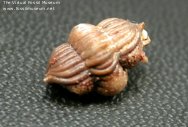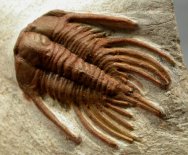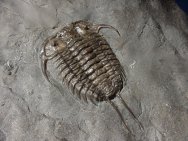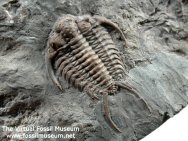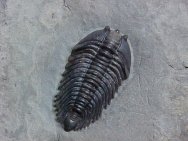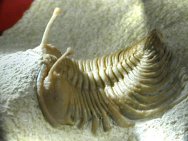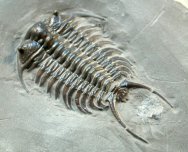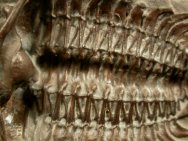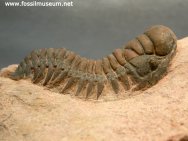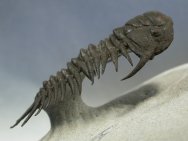| |
Trilobite
Order Phacopida (pronounced Phah-co-pee-da) is large and diverse,
comprising the related suborders Calymenina,
Phacopina, and Cheirurina.
Their grouping mainly derives from a shared and differentiating
form during the early protaspid larval form period. The Phacopids
likely appeared near the base of the Ordovician
as Suborder Calymenina. The Calymenina share hypostomal characteristics
with Order Ptychopariida, and Phacopida exhibits similar tuberculation
with Lichida, confounding
the determination of the Phacopids closest sister group.
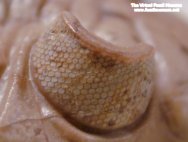 Phacopids
of Suborder Phacopina are the only trilobites to have evolved
the incredible schizochroal form of eyes,
an instance of apparant evolutionary improvement over the
more
common holochroal eyes of suborders Calymenina and Cheirurina
of the Phacopids, most other trilobites, and generally, most
extant arthropods. Holochroal eyes comprise up to 15,000 closely
packed hexagonal lenses underneath a single cornea. In contrast,
the schizochroal eye lens were far fewer in number (less than
about 700), as in juvenile trilobites, in which each lens was
a
separate
calcite spheroid with its own lens, each lens separated by
an inter-lens sclera (cuticle), and covered by its own cornea.
What survival benefit was accrued by this form of eye? -- correction
of spherical aberration. Clarkson and Levi-Setti (1975) determined
that the schizochroal eye was unique in that each lens is biconvex
and is made of two calcite elements with different refractive
indices that were separated by an aspherical surface with an
overall affect that the lens corrected for spherical aberration.
The development of the schizochroal eyes is but one example
in nature of so called post-displacement paedomorphosis, whereby
selective pressures, because survival is benefited, results
in the retaining of traits previously only existing in juvenile
members of a species. The Phacopina thus constitute a notable
example that Life remembers its history, with a memory embedded
in the genomes. This evolutionary innovation has never been
repeated among the Arthropods, though modern arthropods exhibit
a myriad of other remarkable and innovative visual systems. Phacopids
of Suborder Phacopina are the only trilobites to have evolved
the incredible schizochroal form of eyes,
an instance of apparant evolutionary improvement over the
more
common holochroal eyes of suborders Calymenina and Cheirurina
of the Phacopids, most other trilobites, and generally, most
extant arthropods. Holochroal eyes comprise up to 15,000 closely
packed hexagonal lenses underneath a single cornea. In contrast,
the schizochroal eye lens were far fewer in number (less than
about 700), as in juvenile trilobites, in which each lens was
a
separate
calcite spheroid with its own lens, each lens separated by
an inter-lens sclera (cuticle), and covered by its own cornea.
What survival benefit was accrued by this form of eye? -- correction
of spherical aberration. Clarkson and Levi-Setti (1975) determined
that the schizochroal eye was unique in that each lens is biconvex
and is made of two calcite elements with different refractive
indices that were separated by an aspherical surface with an
overall affect that the lens corrected for spherical aberration.
The development of the schizochroal eyes is but one example
in nature of so called post-displacement paedomorphosis, whereby
selective pressures, because survival is benefited, results
in the retaining of traits previously only existing in juvenile
members of a species. The Phacopina thus constitute a notable
example that Life remembers its history, with a memory embedded
in the genomes. This evolutionary innovation has never been
repeated among the Arthropods, though modern arthropods exhibit
a myriad of other remarkable and innovative visual systems.
Phylum Arthropoda
Subphylum Chelicerata
Class Trilobita
Order Phacopida Taxonomy:
Suborder Calymenina
Superfamily Calymenoidea
Family Calymenidae
Family Pharostomatidae
Family Homalonotidae
Family Bavarillidae
Family Bathycheilidae
Suborder Phacopina
Superfamily Phacopoidea
Family Phacopidae
Family Pterygometopidae
Superfamily Dalmanitoidea
Family Dalmanitidae
Family Prosopiscidae
Family Diaphanometopidae
Superfamily Acastoidea
Family Acastidae
Family Calmoniidae
Suborder Cheirurina
Superfamily Cheiruroidea
Family Cheiruridae
Family Pliomeridae
Family Pilekiidae
Family Encrinuridae
Also see potential Phacopida Phylogeny |
|
|
|
|
|
|
|
|
|
Calymene
clavicula
Family
Calymenidae
Middle Silurian
Henryhouse Formation
Oklahoma |
|
|
|
|
Suborder
Phacopina with Schizochroal
Eyes
|
|
|
|
|
|
|
|
| |
|
|
|
| |
|
|
|
|
|
|
|
|
|
Paciphacops
birdsongensis
Superfamily Phacopoidea
Family: Phacopidae
Lower Devonian
Birdsong Formation, Benton County, Tennessee |
Chasmops
praecurrens
Superfamily Phacopoidea
Family Pterygometopidae
Middle Ordovician
Wolchow river, Russia |
|
|
|
|
|
Kainops
raymondi
Superfamily Phacopoidea
Family Phacopidae
Lower Devonian
Haragan Formation
Oklahoma |
Acastocephala
macrops
Superfamily Acastoidea Family Acastidae
Middle Silurian
Wenlock Edge, Shropshire, England |
|
|
|
|
|
|
Dalmanites
limulurus
Family Dalmanitidae
Middle Silurian
Rochester Shale Formation
Middleport, New York
|
|
|
|
|
|
|
|
|
|
Pliomera
fisheri
Suborder Cheirurina
Family Pliomeridae
Middle Ordovician
Wolchow river, Russia |
|
|
|
|
|
|
|
|
Pseudocybele
nasuta
Suborder Cheirurina
Superfamily Pilekiidae
Family Pliomeridae
Ordovician
Fillmore Formation
Millard County, Utah |
Cybele
bellatula
Suborder Cheirurrina
Superfamily Cheiruroidea
Family Encrinuridae
Lower Ordovician
Wolchow river, Russia |
|
|
|
|
|
|
Lehua
ponti
Family Cheiruridae
Ordovician
Zagora, Morocco |
Crotalocephalina
(Crotalocephalus) gibbus
Family Cheiruridae
Devonian
Alnif, Morocco |
|
|
|
|
|
|
|
|
Phacopid Phylogeny
Trilobita
`--Phacopida
|--Calymenina
| |--Pharostomatidae
| |--Homalonotidae
| |--Bavarillidae
| `--Bathycheilidae
|--Phacopina
| |--Dalmanitoidea
| | |--Dalmanitidae
| | |--Prosopiscidae
| | `--Diaphanometopidae
| `--Acastoidea
| |--Acastidae
| `--Calmoniidae
`--Cheirurina
|--Cheiruridae
|--Pliomeridae
|--Pilekiidae
`--Encrinuridae |
Clarkson, E. N. K., and Levi-Setti,
R., Nature, 254, 663–667 (1975).
|
|
| |


